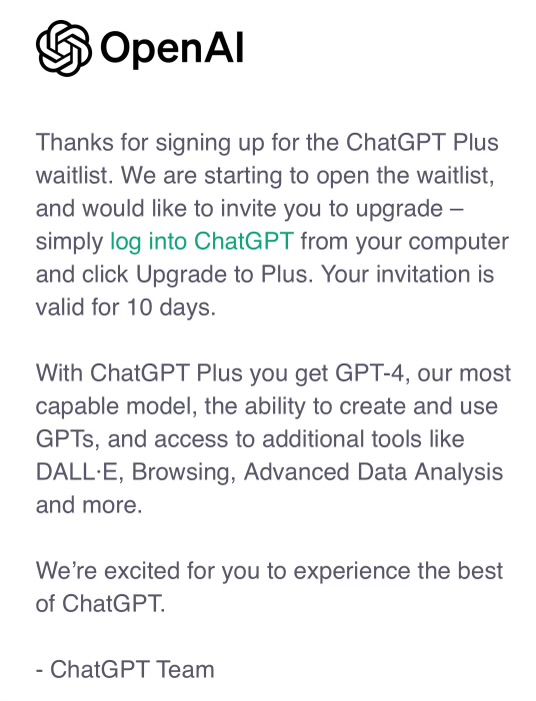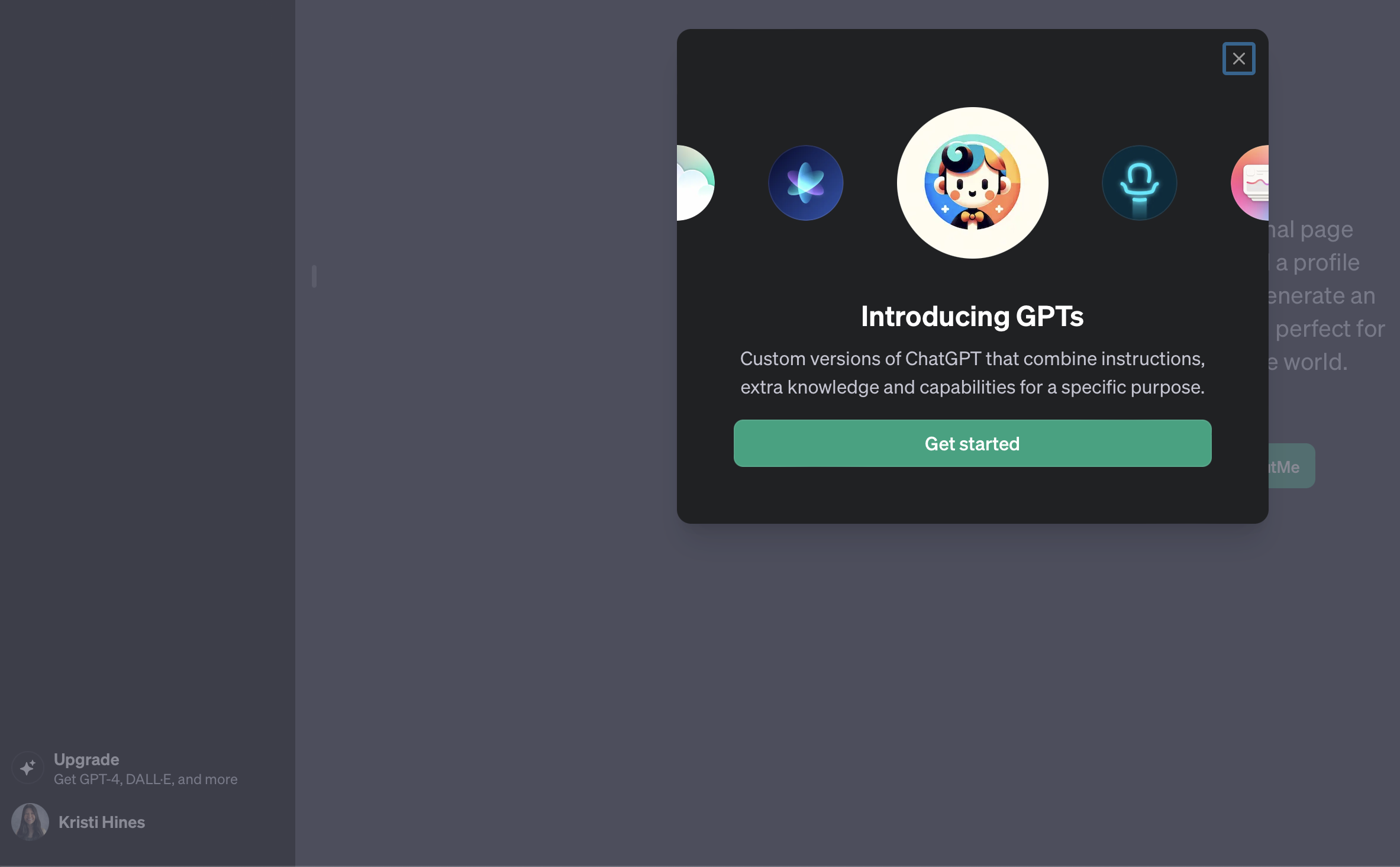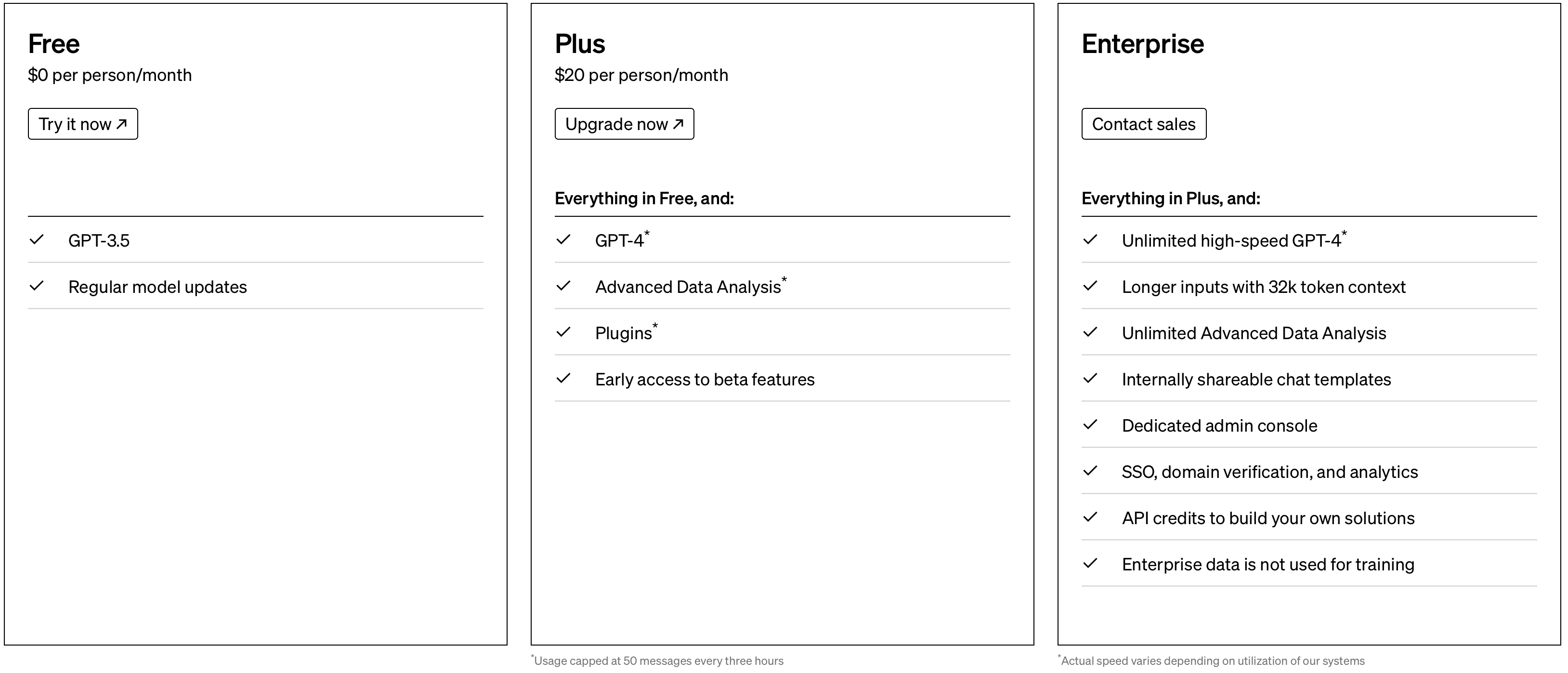SEO
ChatGPT Plus Upgrades Paused; Waitlisted Users Receive Invites

ChatGPT Plus subscriptions and upgrades remain paused after a surge in demand for new features created outages.
Some users who signed up for the waitlist have received invites to join ChatGPT Plus.

This has resulted in a few shares of the link that is accessible for everyone. For now.
Found a hack to skip chatGPT plus wait list.
Follow the steps
– login to ChatGPT
– now if you click on upgrade
– Signup for waitlist(may not be necessary)
– now change the URL to https://t.co/4izOdNzarG
– Wallah you are in for payment #ChatGPT4 #hack #GPT4 #GPTPlus pic.twitter.com/J1GizlrOAx— Ashish Mohite is building Notionpack Capture (@_ashishmohite) December 8, 2023
RELATED: GPT Store Set To Launch In 2024 After ‘Unexpected’ Delays
In addition to the invites, signs that more people are getting access to GPTs include an introductory screen popping up on free ChatGPT accounts.
 Screenshot from ChatGPT, December 2023
Screenshot from ChatGPT, December 2023
Unfortunately, they still aren’t accessible without a Plus subscription.
 Screenshot from ChatGPT, December 2023
Screenshot from ChatGPT, December 2023
You can sign up for the waitlist by clicking on the option to upgrade in the left sidebar of ChatGPT on a desktop browser.
 Screenshot from ChatGPT, December 2023
Screenshot from ChatGPT, December 2023
OpenAI also suggests ChatGPT Enterprise for those who need more capabilities, as outlined in the pricing plans below.
 Screenshot from OpenAI, December 2023
Screenshot from OpenAI, December 2023
Why Are ChatGPT Plus Subscriptions Paused?
According to a post on X by OpenAI’s CEO Sam Altman, the recent surge in usage following the DevDay developers conference has led to capacity challenges, resulting in the decision to pause ChatGPT Plus signups.
we are pausing new ChatGPT Plus sign-ups for a bit 🙁
the surge in usage post devday has exceeded our capacity and we want to make sure everyone has a great experience.
you can still sign-up to be notified within the app when subs reopen.
— Sam Altman (@sama) November 15, 2023
The decision to pause new ChatGPT signups follows a week where OpenAI services – including ChatGPT and the API – experienced a series of outages related to high-demand and DDoS attacks.
Demand for ChatGPT Plus resulted in eBay listings supposedly offering one or more months of the premium subscription.
chatgpt plus accounts selling ebay for a premium 🫡🇺🇸 https://t.co/VdN8tuexKM pic.twitter.com/W522NGHsRV
— surya (@sdand) November 15, 2023
When Will ChatGPT Plus Subscriptions Resume?
So far, we don’t have any official word on when ChatGPT Plus subscriptions will resume. We know the GPT Store is set to open early next year after recent boardroom drama led to “unexpected delays.”
Therefore, we hope that OpenAI will onboard waitlisted users in time to try out all of the GPTs created by OpenAI and community builders.
What Are GPTs?
GPTs allow users to create one or more personalized ChatGPT experiences based on a specific set of instructions, knowledge files, and actions.
Search marketers with ChatGPT Plus can try GPTs for helpful content assessment and learning SEO.
Two SEO GPTs I’ve created for assessment + learning 👀👇
1. Content Helpfulness and Quality SEO Analyzer: Assess a page content helpfulness, relevance, and quality for your targeted query based on Google’s guidelines vs your competitors and get tips: https://t.co/LsoP2UhF4N pic.twitter.com/O77MHiqwOq
— Aleyda Solis 🕊️ (@aleyda) November 12, 2023
2. The https://t.co/IFmKxxVDpW SEO Teacher: A friendly SEO expert teacher who will help you to learn SEO using reliable https://t.co/sCZ03C7fzq resources: https://t.co/UrMPUYwblH
I hope they’re helpful 🙌🤩
PS: Love how GPT opens up to SO much opportunity 🤯 pic.twitter.com/yqKozcZTDc
— Aleyda Solis 🕊️ (@aleyda) November 12, 2023
There are also GPTs for analyzing Google Search Console data.
oh wow. I think this GPT works.
Export data from GSC comparing keyword rankings before and after an update and upload it to ChatGPT and it will spit out this scatter plot for you.
It’s an easy way to see if most of your keyword declined or improved.
This site was impacted by… pic.twitter.com/wFGSnonqoZ
— Marie Haynes (@Marie_Haynes) November 9, 2023
And GPTs that will let you chat with analytics data from 20 platforms, including Google Ads, GA4, and Facebook.
Google search has indexed hundreds of public GPTs. According to an alleged list of GPT statistics in a GitHub repository, DALL-E, the top GPT from OpenAI, has received 5,620,981 visits since its launch last month. Included in the top 20 GPTs is Canva, with 291,349 views.
Weighing The Benefits Of The Pause
Ideally, this means that developers working on building GPTs and using the API should encounter fewer issues (like being unable to save GPT drafts).
But it could also mean a temporary decrease in new users of GPTs since they are only available to Plus subscribers – including the ones I tested for learning about ranking factors and gaining insights on E-E-A-T from Google’s Search Quality Rater Guidelines.
 Screenshot from ChatGPT, November 2023
Screenshot from ChatGPT, November 2023
Featured image: Robert Way/Shutterstock
SEO
Competing Against Brands & Nouns Of The Same Name

Establishing and building a brand has always been both a challenge and an investment, even before the days of the internet.
One thing the internet has done, however, is make the world a lot smaller, and the frequency of brand (or noun) conflicts has greatly increased.
In the past year, I’ve been emailed and asked questions about these conflicts at conferences more than I have in my entire SEO career.
When you share your brand name with another brand, town, or city, Google has to decide and determine the dominant user interpretation of the query – or at least, if there are multiple common interpretations, the most common interpretations.
Noun and brand conflicts typically happen when:
- A rebrand’s research focuses on other business names and doesn’t take into consideration general user search.
- When a brand chooses a word in one language, but it has a use in another.
- A name is chosen that is also a noun (e.g. the name of a town or city).
Some examples include Finlandia, which is both a brand of cheese and vodka; Graco, which is both a brand of commercial products and a brand of baby products; and Kong, which is both the name of a pet toy manufacturer and a tech company.
User Interpretations
From conversations I’ve had with marketers and SEO pros working for various brands with this issue, the underlying theme (and potential cause) comes down to how Google handles interpretation of what users are looking for.
When a user enters a query, Google processes the query to identify known entities that are contained.
It does this to improve the relevance of search results being returned (as outlined in its 2015 Patent #9,009,192). From this, Google also works to return related, relevant results and search engine results page (SERP) elements.
For example, when you search for a specific film or TV series, Google may return a SERP feature containing relevant actors or news (if deemed relevant) about the media.
This then leads to interpretation.
When Google receives a query, the search results need to often cater for multiple common interpretations and intents. This is no different when someone searches for a recognized branded entity like Nike.
When I search for Nike, I get a search results page that is a combination of branded web assets such as the Nike website and social media profiles, the Map Pack showing local stores, PLAs, the Nike Knowledge Panel, and third-party online retailers.
This variation is to cater for the multiple interpretations and intents that a user just searching for “Nike” may have.
Brand Entity Disambiguation
Now, if we look at brands that share a name such as Kong, when Google checks for entities and references against the Knowledge Graph (and knowledge base sources), it gets two closer matches: Kong Company and Kong, Inc.
The search results page is also littered with product listing ads (PLAs) and ecommerce results for pet toys, but the second blue link organic result is Kong, Inc.
Also on page one, we can find references to a restaurant with the same name (UK-based search), and in the image carousel, Google is introducing the (King) Kong film franchise.
It is clear that Google sees the dominant interpretation of this query to be the pet toy company, but has diversified the SERP further to cater for secondary and tertiary meanings.
In 2015, Google was granted a patent that included features of how Google might determine differences in entities of the same name.
This includes the possible use of annotations within the Knowledge Base – such as the addition of a word or descriptor – to help disambiguate entities with the same name. For example, the entries for Dan Taylor could be:
- Dan Taylor (marketer).
- Dan Taylor (journalist).
- Dan Taylor (olympian).
How it determines what is the “dominant” interpretation of the query, and then how to order search results and the types of results, from experience, comes down to:
- Which results users are clicking on when they perform the query (SERP interaction).
- How established the entity is within the user’s market/region.
- How closely the entity is related to previous queries the user has searched (personalization).
I’ve also observed that there is a correlation between extended brand searches and how they affect exact match branded search.
It’s also worth highlighting that this can be dynamic. Should a brand start receiving a high volume of mentions from multiple news publishers, Google will take this into account and amend the search results to better meet users’ needs and potential query interpretations at that moment in time.
SEO For Brand Disambiguation
Building a brand is not a task solely on the shoulders of SEO professionals. It requires buy-in from the wider business and ensuring the brand and brand messaging are both defined and aligned.
SEO can, however, influence this effort through the full spectrum of SEO: technical, content, and digital PR.
Google understands entities on the concept of relatedness, and this is determined by the co-occurrence of entities and then how Google classifies and discriminates between those entities.
We can influence this through technical SEO through granular Schema markup and by making sure the brand name is consistent across all web properties and references.
This ties into how we then write about the brand in our content and the co-occurrence of the brand name with other entity types.
To reinforce this and build brand awareness, this should be coupled with digital PR efforts with the objective of brand placement and corroborating topical relevance.
A Note On Search Generative Experience
As it looks likely that Search Generative Experience is going to be the future of search, or at least components of it, it’s worth noting that in tests we’ve done, Google can, at times, have issues when generative AI snapshots for brands, when there are multiple brands with the same name.
To check your brand’s exposure, I recommend asking Google and generating an SGE snapshot for your brand + reviews.
If Google isn’t 100% sure which brand you mean, it will start to include reviews and comments on companies of the same (or very similar) name.
It does disclose that they are different companies in the snapshot, but if your user is skim-reading and only looking at the summaries, this could be an accidental negative brand touchpoint.
More resources:
Featured Image: VectorMine/Shutterstock
SEO
Google Rolls Out New ‘Web’ Filter For Search Results

Google is introducing a filter that allows you to view only text-based webpages in search results.
The “Web” filter, rolling out globally over the next two days, addresses demand from searchers who prefer a stripped-down, simplified view of search results.
Danny Sullivan, Google’s Search Liaison, states in an announcement:
“We’ve added this after hearing from some that there are times when they’d prefer to just see links to web pages in their search results, such as if they’re looking for longer-form text documents, using a device with limited internet access, or those who just prefer text-based results shown separately from search features.”
We’ve added this after hearing from some that there are times when they’d prefer to just see links to web pages in their search results, such as if they’re looking for longer-form text documents, using a device with limited internet access, or those who just prefer text-based…
— Google SearchLiaison (@searchliaison) May 14, 2024
The new functionality is a throwback to when search results were more straightforward. Now, they often combine rich media like images, videos, and shopping ads alongside the traditional list of web links.
How It Works
On mobile devices, the “Web” filter will be displayed alongside other filter options like “Images” and “News.”
If Google’s systems don’t automatically surface it based on the search query, desktop users may need to select “More” to access it.
 Screenshot from: twitter.com/GoogleSearchLiaison, May 2024.
Screenshot from: twitter.com/GoogleSearchLiaison, May 2024.More About Google Search Filters
Google’s search filters allow you to narrow results by type. The options displayed are dynamically generated based on your search query and what Google’s systems determine could be most relevant.
The “All Filters” option provides access to filters that are not shown automatically.
Alongside filters, Google also displays “Topics” – suggested related terms that can further refine or expand a user’s original query into new areas of exploration.
For more about Google’s search filters, see its official help page.
Featured Image: egaranugrah/Shutterstock
SEO
Why Google Can’t Tell You About Every Ranking Drop

In a recent Twitter exchange, Google’s Search Liaison, Danny Sullivan, provided insight into how the search engine handles algorithmic spam actions and ranking drops.
The discussion was sparked by a website owner’s complaint about a significant traffic loss and the inability to request a manual review.
Sullivan clarified that a site could be affected by an algorithmic spam action or simply not ranking well due to other factors.
He emphasized that many sites experiencing ranking drops mistakenly attribute it to an algorithmic spam action when that may not be the case.
“I’ve looked at many sites where people have complained about losing rankings and decide they have a algorithmic spam action against them, but they don’t. “
Sullivan’s full statement will help you understand Google’s transparency challenges.
Additionally, he explains why the desire for manual review to override automated rankings may be misguided.
Two different things. A site could have an algorithmic spam action. A site could be not ranking well because other systems that *are not about spam* just don’t see it as helpful.
I’ve looked at many sites where people have complained about losing rankings and decide they have a…
— Google SearchLiaison (@searchliaison) May 13, 2024
Challenges In Transparency & Manual Intervention
Sullivan acknowledged the idea of providing more transparency in Search Console, potentially notifying site owners of algorithmic actions similar to manual actions.
However, he highlighted two key challenges:
- Revealing algorithmic spam indicators could allow bad actors to game the system.
- Algorithmic actions are not site-specific and cannot be manually lifted.
Sullivan expressed sympathy for the frustration of not knowing the cause of a traffic drop and the inability to communicate with someone about it.
However, he cautioned against the desire for a manual intervention to override the automated systems’ rankings.
Sullivan states:
“…you don’t really want to think “Oh, I just wish I had a manual action, that would be so much easier.” You really don’t want your individual site coming the attention of our spam analysts. First, it’s not like manual actions are somehow instantly processed. Second, it’s just something we know about a site going forward, especially if it says it has change but hasn’t really.”
Determining Content Helpfulness & Reliability
Moving beyond spam, Sullivan discussed various systems that assess the helpfulness, usefulness, and reliability of individual content and sites.
He acknowledged that these systems are imperfect and some high-quality sites may not be recognized as well as they should be.
“Some of them ranking really well. But they’ve moved down a bit in small positions enough that the traffic drop is notable. They assume they have fundamental issues but don’t, really — which is why we added a whole section about this to our debugging traffic drops page.”
Sullivan revealed ongoing discussions about providing more indicators in Search Console to help creators understand their content’s performance.
“Another thing I’ve been discussing, and I’m not alone in this, is could we do more in Search Console to show some of these indicators. This is all challenging similar to all the stuff I said about spam, about how not wanting to let the systems get gamed, and also how there’s then no button we would push that’s like “actually more useful than our automated systems think — rank it better!” But maybe there’s a way we can find to share more, in a way that helps everyone and coupled with better guidance, would help creators.”
Advocacy For Small Publishers & Positive Progress
In response to a suggestion from Brandon Saltalamacchia, founder of RetroDodo, about manually reviewing “good” sites and providing guidance, Sullivan shared his thoughts on potential solutions.
He mentioned exploring ideas such as self-declaration through structured data for small publishers and learning from that information to make positive changes.
“I have some thoughts I’ve been exploring and proposing on what we might do with small publishers and self-declaring with structured data and how we might learn from that and use that in various ways. Which is getting way ahead of myself and the usual no promises but yes, I think and hope for ways to move ahead more positively.”
Sullivan said he can’t make promises or implement changes overnight, but he expressed hope for finding ways to move forward positively.
Featured Image: Tero Vesalainen/Shutterstock
-

 SEO7 days ago
SEO7 days agoHow to Use Keywords for SEO: The Complete Beginner’s Guide
-

 MARKETING5 days ago
MARKETING5 days agoAdvertising on Hulu: Ad Formats, Examples & Tips
-

 MARKETING2 days ago
MARKETING2 days ago18 Events and Conferences for Black Entrepreneurs in 2024
-

 WORDPRESS5 days ago
WORDPRESS5 days agoBest WordPress Plugins of All Time: Updated List for 2024
-

 MARKETING6 days ago
MARKETING6 days agoUpdates to data build service for better developer experiences
-

 MARKETING7 days ago
MARKETING7 days agoThe Ultimate Guide to Email Marketing
-

 WORDPRESS6 days ago
WORDPRESS6 days agoShopify Could Be Undervalued Based On A Long-Term Horizon
-

 PPC6 days ago
PPC6 days agoLow Risk, High Reward YouTube Ads alexking















